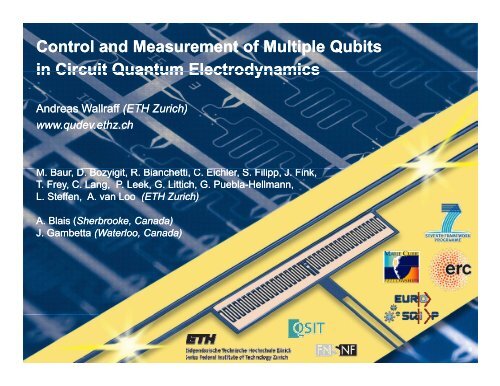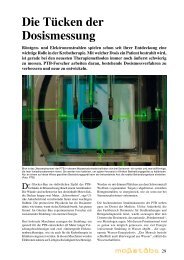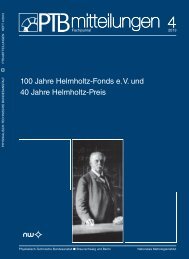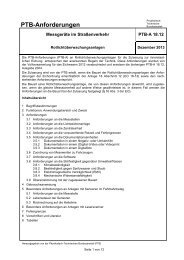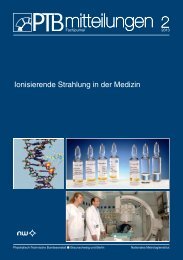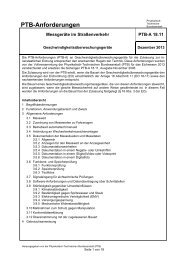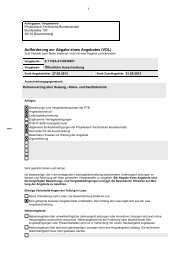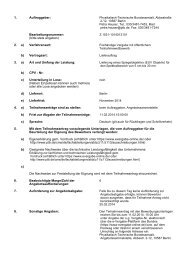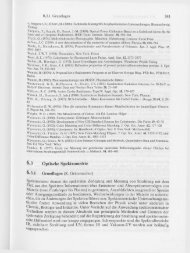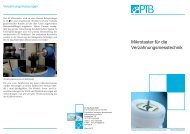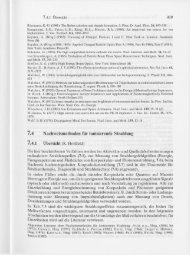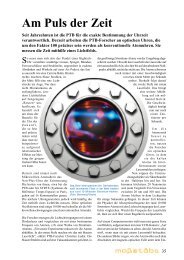A. Wallraff, Control and measurement of multiple qubits - PTB
A. Wallraff, Control and measurement of multiple qubits - PTB
A. Wallraff, Control and measurement of multiple qubits - PTB
You also want an ePaper? Increase the reach of your titles
YUMPU automatically turns print PDFs into web optimized ePapers that Google loves.
<strong>Control</strong> <strong>and</strong> Measurement <strong>of</strong> Multiple Qubits<br />
in in Circuit Circuit Quantum Quantum Electrodynamics<br />
Electrodynamics<br />
Andreas <strong>Wallraff</strong> (ETH Zurich)<br />
www.qudev.ethz.ch<br />
M M. Baur, BBaur, D D. B BBozyigit Bozyigit, i i , R RR.<br />
. Bi Bianchetti Bianchetti, h i i, C C. Ei Eichler Eichler, hl , S SS.<br />
. Fili Filipp Filipp, , J J. Fi Fink, k<br />
T. Frey, CC.<br />
. Lang, P. Leek, G. Littich, G. Puebla-Hellmann,<br />
Puebla Hellmann,<br />
L. . Steffen, A. van Loo (ETH ETH Zurich)<br />
A A. Bl Blais i (Sh (Sherbrooke<br />
Sh Sherbrooke, b k , C Canada) d )<br />
J. Gambetta (Waterloo, Canada Canada)
<strong>Control</strong>ling the Interaction <strong>of</strong> Light <strong>and</strong> Matter ...<br />
... is challenging on the level <strong>of</strong> single (artificial) atoms <strong>and</strong> single photons<br />
• dipole moment d (usually small in atoms ~ ea 0)<br />
• single photon fields E 0 (small in 3D)<br />
• photon/atom interaction (usually small)<br />
d <strong>and</strong> E 0 can be controlled in superconducting circuits:<br />
• perform basic quantum optics experiments<br />
D. Walls, G. Milburn, Quantum Optics (Spinger-Verlag, Berlin, 1994)
Cavity Quantum Electrodynamics
Circuit Realization <strong>of</strong> Cavity QED<br />
... in superconducting circuits:<br />
with individual photons <strong>and</strong> <strong>qubits</strong> ...<br />
A. Blais, et al., PRA 69, 062320 (2004)<br />
A. <strong>Wallraff</strong> et al., Nature (London) 431, 162 (2004)
elements:<br />
• the cavity: a superconducting 1D transmission line resonator<br />
with large vacuum field E 0 <strong>and</strong> long photon life time 1/<br />
• the artificial atom: a superconducting qubit with large dipole<br />
<br />
A. Blais et al., PRA 69, 062320 (2004)
Resonant Vacuum Rabi Mode Splitting …<br />
first demonstration in a solid: A. <strong>Wallraff</strong> et al., Nature (London) 431, 162 (2004)<br />
this data: J. Fink et al., Nature (London) 454, 315 (2008)<br />
R. J. Schoelkopf, S. M. Girvin, Nature (London) 451, 664 (2008)
5 Years <strong>of</strong> Quantum Electrodynamics with Circuits<br />
Quantum AC-Stark Shift<br />
D. Schuster et al., Nature 445, 515 (2007)<br />
Lamb Shift<br />
A. Fragner et al., Science 322, 1357 (2008)<br />
Fock <strong>and</strong> Arbitrary Photon States<br />
MM. HH<strong>of</strong>heinz fh i et t al., l NNature t 454, 30(2008)<br />
310 (2008)<br />
M. H<strong>of</strong>heinz et al., Nature 459, 546 (2009)<br />
Root n Nonlinearityy<br />
J. Fink et al., Nature 454, 315 (2008)<br />
Two Photon Nonlinearities<br />
F. Deppe et al., Nat. Phys. 4, 686 (2008)<br />
Super Splitting <strong>and</strong> Root n Nonlinearity<br />
L. Bishop et al., Nat. Phys. 5, 105 (2009)<br />
Vacuum Rabi Mode Splitting<br />
A. <strong>Wallraff</strong> et al., Nature 431, 162 (2004)<br />
Coherent Flux-Qubit / SQUID Coupling<br />
I. Chiorescu et al., Nature 431, 159 (2004)<br />
Single Photon Source<br />
A. Houck et al., , Nature 449, 449,3 328 (2007) ( 7)<br />
Single Qubit MASER<br />
O. Astafiev et al., Nature 449, 588 (2007)<br />
Cooling <strong>and</strong> Amplification<br />
M. Grajcar et al., Nat. Phys. 4, 612 (2008)<br />
Quantum Bus<br />
M. Sillanpaa et al., Nature 449, 438 (2007)<br />
H. Majer et al., Nature 449, 443 (2007)<br />
L. DiCarlo et al., Nature 460, 240-244 (2009)
Cavity QED with Multiple Photons Atoms<br />
li N t t i l h t<br />
. Rev. Lett. 103, 083601 (2009)<br />
coupling nn photons to single atom
Multi-Atom Cavity QED
Multi-Qubit Circuit QED Schematic
Three Qubit Circuit QED Setup
Three Qubit Circuit QED Sample
N = 1, 2, 3 Qubit – Cavity Anti Crossing<br />
, Phys. Rev. Lett. 103, 083601 (2009)
• th the spectrum: t<br />
• the states:<br />
states equally shared<br />
between photon <strong>and</strong> qubit
• th the spectrum: t<br />
• the states:<br />
bright states: superposition<br />
<strong>of</strong> a photon <strong>and</strong> a Bell state<br />
dark state
• th the spectrum: t<br />
• the states:<br />
one photon h t plus l th three<br />
qubit entagled W-state<br />
two dark states
• th the spectrum: t<br />
• scaling <strong>of</strong> collective coupling with<br />
J. Fink et al., Phys. Rev. Lett. 103, 083601 (2009)
This work:<br />
• excitation spectrum <strong>of</strong> 4 coupled quantum systems measured<br />
• Tavis-Cummings model tested in the discrete limit<br />
• a step towards multi-qubit QIPC in circuit QED<br />
The future:<br />
• investigate collective excitations with small but fixed number <strong>of</strong><br />
<strong>qubits</strong><br />
• Dicke states<br />
• ssuperradiance perradiance<br />
• generate complex entangled states using collective interactions
quantum bus<br />
g g g<br />
Leek et al., Phys. Rev. B 79, 180511(R) (2009)<br />
• controlling photon life times on the quantum bus<br />
P. Leek, M. Baur et al., Quantum Device Lab (2009)<br />
• measuring i entanglement t l t bby joint j i t read-out d t with itha single i l ddetector t t<br />
Filipp et al., Phys. Rev. Lett. 102, 200402 (2009)
Circuit QED for Quantum Information Processing<br />
benefits <strong>of</strong> architecture:<br />
• isolation <strong>of</strong> <strong>qubits</strong> from environment<br />
•maintains i i addressability<br />
dd bili<br />
• quantum non-demolition qubit read out<br />
• conversion <strong>of</strong> quantum information between <strong>qubits</strong> <strong>and</strong> photons<br />
• long-range photon mediated qubit/qubit interactions
Out <strong>of</strong> Single Qubit<br />
L. Steffen et al., Quantum Device Lab, ETH Zurich (2008)
Qubit Coherence: Tomography <strong>of</strong> Ramsey Experiment
qubit A<br />
qubit A<br />
qubit B<br />
• Two near identical<br />
superconducting <strong>qubits</strong><br />
~ 8 mm • Local control <strong>of</strong><br />
coupling bus<br />
~<br />
selective qubit drive line<br />
magnetic flux allows<br />
independent p selection <strong>of</strong><br />
qubit transition<br />
frequencies<br />
• Local drive lines allow<br />
selective excitation <strong>of</strong><br />
individual <strong>qubits</strong>
Resonator Sideb<strong>and</strong> Transitions<br />
simultaneous excitation <strong>of</strong> qubit <strong>and</strong> resonator: |g,0> |e,1><br />
entangle a qubit with a photon on the bus: |g,0> |g,0> + |e,1>
st<strong>and</strong>ard resonator configuration coupled at in <strong>and</strong> output:<br />
all modes:<br />
• nominally yidentical Q<br />
• identical photon life time<br />
P. Leek et al., Quantum Device Lab (2007-2009)
Engineering Mode–Dependent Photon Life Times<br />
center coupled resonator configuration:<br />
odd modes are decoupled:<br />
•high g Q<br />
• long photon life time<br />
• coherent manipulation<br />
P. Leek et al., Quantum Device Lab (2007-2009)
Engineering Mode–Dependent Photon Life Times<br />
center coupled resonator configuration:<br />
even modes are strongly coupled:<br />
• low Q<br />
• short photon life time<br />
• dispersive qubit <strong>measurement</strong><br />
P. Leek et al., Quantum Device Lab (2007-2009)
Realization<br />
P. Leek et al., Quantum Device Lab (2007-2009)
fundamental:<br />
• odd mode<br />
• decoupled<br />
•high Q<br />
• long life time<br />
1st harmonic:<br />
•even mode<br />
•coupled<br />
• low Q<br />
• short life time<br />
2nd harmonic:<br />
•odd<br />
• decoupled<br />
•high Q<br />
• long life time<br />
storage mode <strong>measurement</strong> mode<br />
storage mode<br />
P. Leek et al., Quantum Device Lab (2007-2009)
• low Q mode (T 1 1 ~ 39 ns)<br />
• high Q mode (T 2 • high Q mode (T1 ~1600ns)<br />
~ 1600 ns)<br />
M. Baur, P. Leek et al., Quantum Device Lab (2009)
:<br />
• create Fock state with<br />
blue sideb<strong>and</strong> pulse<br />
• return qubit to |g><br />
•wait<br />
• bring qubit to |e><br />
• annihilate Fock state with<br />
blue sideb<strong>and</strong> pulse<br />
• measure qubit state<br />
:<br />
Fock-State (n=1)<br />
high Q photon<br />
T 1, ~ 1.45 s<br />
M. Baur, P. Leek et al., Quantum Device Lab (2009)
pulse sequence:<br />
high Q photon<br />
T *<br />
2, ~ 19s 1.9 s<br />
M. Baur, P. Leek et al., Quantum Device Lab (2009)
Side B<strong>and</strong> Rabi Oscillations with Fock-States n = 0, 1, 2<br />
p p<br />
states with BSB<br />
• scaling <strong>of</strong> Rabi<br />
frequency<br />
Ωn ∝ √ nΩ1<br />
• imperfections due<br />
to preparation<br />
MB M. Baur, P. PLLeekket t al., l<br />
Quantum Device Lab (2009)<br />
Ω<br />
Ω1<br />
√ 2Ω1<br />
√ 3Ω1<br />
prospects:<br />
p p<br />
towards ion-trap style 2-qubit gates (sideb<strong>and</strong> CNOT gate):<br />
Cirac/Zoller, Sorensen/Molmer, Chuang, ...
Two-Mode Bell-State Generation <strong>and</strong> Measurement
Two-Mode Bell-State Generation <strong>and</strong> Measurement<br />
storage<br />
<strong>measurement</strong><br />
P. Leek, M. Baur et al., Quantum Device Lab (2009)
Photons Photons: Weihs et et al., al PRL 81 (1998) (1998); supercond supercond. <strong>qubits</strong> <strong>qubits</strong>: Steffen et et al., al Science 313 (2006) (2006).
Correlation Measurement with Individual Readout<br />
table <strong>of</strong> single shot values (±1):<br />
k σ z k ⊗ 1<br />
1 +1<br />
2 -1<br />
… …<br />
K -1
Correlation Measurement with Individual Readout<br />
table <strong>of</strong> single shot values (±1):<br />
k σ z k ⊗ 1 1 ⊗ σz k<br />
1 +1 +1<br />
2 -1 -1<br />
… … …<br />
K -1 +1
Correlation Measurement with Individual Readout<br />
table <strong>of</strong> single shot values (±1):<br />
k σ z k ⊗ 1 1 ⊗ σz k σ z k ⊗ σz k<br />
1 +1 +1 (+1).(+1) = +1<br />
2 -1 -1 (-1).(-1) = +1<br />
… … … …<br />
K -1 +1 (-1).(+1)=-1
Correlation Measurement with Individual Readout<br />
rotation <strong>of</strong> qubit: h σ x ⊗ 1i, h 1 ⊗ σ zi <strong>and</strong> h σ x ⊗ σ zi are measured
Correlation Measurement with Individual Readout<br />
orh σ x ⊗ 1i, h 1 ⊗ σ yi <strong>and</strong> h σ x ⊗ σ yi, a.s.o.<br />
-> all combinations <strong>of</strong> {σ x, σ y, σ z} give full information about the state
Correlation Measurement with Joint Readout<br />
• only single detection device<br />
• plus single qubit operations<br />
Circuit QED-Setup:
Homodyne Measurement <strong>of</strong> Cavity Frequency Shift<br />
Amplitude difference (δQ) depends on state <strong>of</strong> both <strong>qubits</strong>:<br />
qubit-qubit correlations can be determined from<br />
transmission <strong>measurement</strong><br />
& Schoelkopf, PRA 69, 062320 (2004)
experimental<br />
state fidelity:<br />
F = 86%<br />
concurrence: Pure<br />
F 0.541 = 100%<br />
entanglement<br />
<strong>of</strong> formation :<br />
0.371<br />
overlap with<br />
calculation l l ti<br />
F = 99%
experimental<br />
state fidelity:<br />
F = 86%<br />
Pure<br />
concurrence:<br />
F = 100%<br />
0.518<br />
entanglement<br />
<strong>of</strong> formation :<br />
0.374<br />
overlap with<br />
calculation l l ti<br />
F = 99%<br />
P. Leek et al., Phys. Rev. B 79, 180511(R) (2009)<br />
S. Filipp et al., Phys. Rev. Lett. 102, 200402 (2009)
N atom t cavity it QED ...<br />
• test <strong>of</strong> Tavis-Cummings model<br />
... generation <strong>of</strong> all 4 Bell states using sideb<strong>and</strong>s ...<br />
• towards a universal gate<br />
... realization <strong>of</strong> two qubit tomography<br />
• correlations w/o single-shot g <strong>measurement</strong><br />
• using joint dispersive read-out
The ETH Zurich Quantum Device Lab<br />
PostDoc Positions Available


